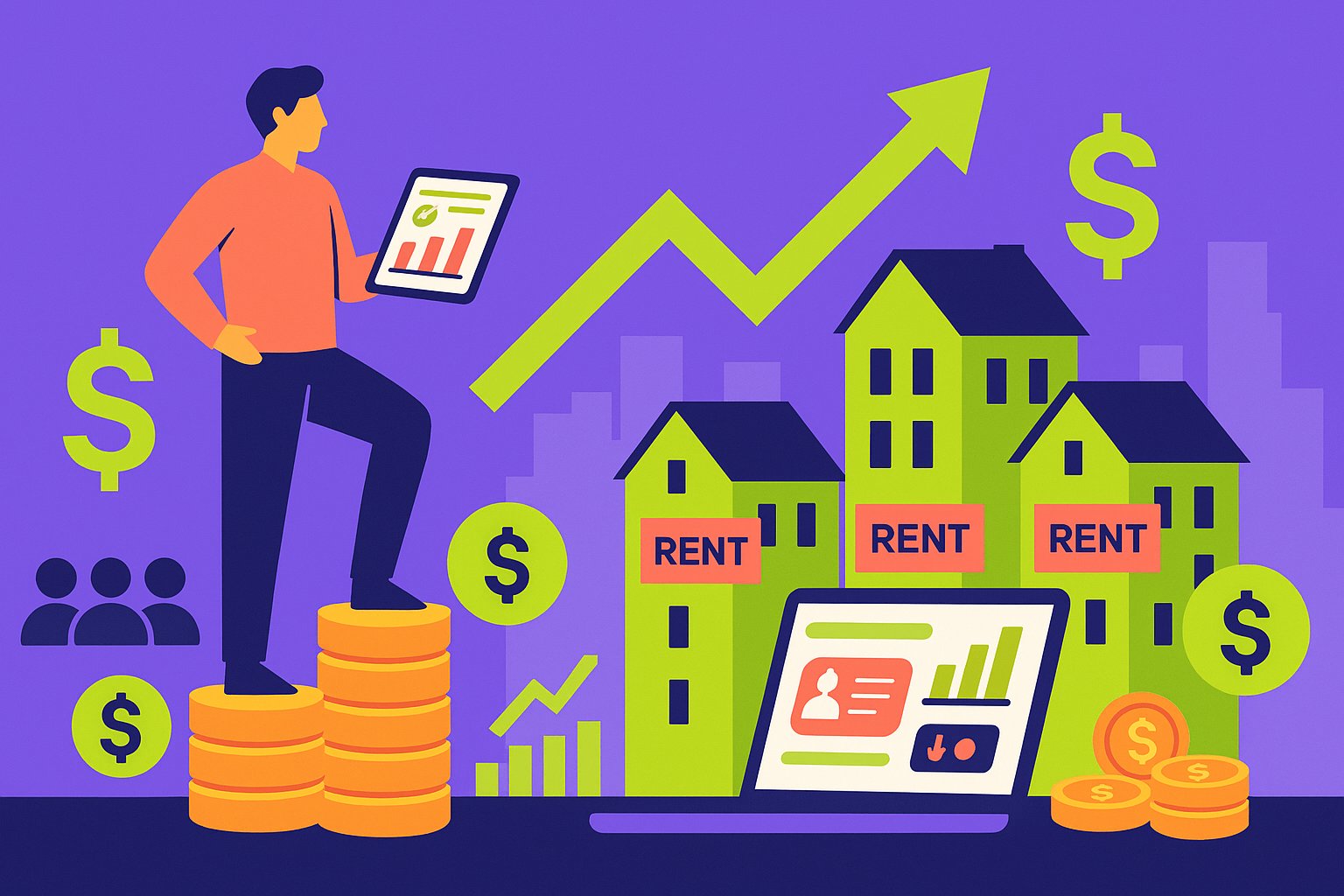Unlocking the Power of Crowdfunded Real Estate
Imagine earning robust rental income without the headaches of property management, tenant disputes, or hefty down payments. Welcome to the era of crowdfunded property investments—a digital frontier that democratizes access to premium rental assets. By pooling capital with other investors, you can tap into multi-unit residential buildings, commercial complexes, and niche rental properties that historically were beyond reach. Whether you’re a seasoned landlord seeking to diversify or a beginner eager to build passive cash flow, crowdfunded investments offer a compelling path. In this journey, we will explore strategies to maximize rental income through these platforms, blending traditional real estate wisdom with cutting-edge technology to supercharge your returns.
Decoding Rental Income in Crowdfunded Offerings
At the heart of any profitable rental strategy lies an understanding of income dynamics. Unlike direct property ownership—where you oversee tenants, repairs, and local regulations—crowdfunding platforms streamline these responsibilities by partnering with experienced sponsors and property managers. When you invest in a residential apartment complex via crowdfunding, you typically receive a share of net rental income generated after expenses such as property management fees, maintenance costs, and reserves for capital improvements. This model allows you to benefit from occupancy rates, rental rate escalations, and professional cost controls without deploying six-figure equity or handling day-to-day operations. By learning how these platforms calculate and distribute rental cash flow, you gain clarity on how your returns correlate with on-the-ground performance metrics.
Choosing High-Yield Crowdfunded Rental Assets
Not every crowdfunding deal is created equal. Identifying high-yield rental assets requires a blend of market research, sponsor evaluation, and underwriting scrutiny. Begin by examining local market fundamentals—supply-and-demand trends, employment growth, and demographic shifts. Urban cores with limited housing inventory often experience rising rents, while college towns or secondary cities can offer attractive yields if student enrollment or job creation trends remain strong. Next, scrutinize the sponsor’s track record: how many rental properties have they acquired and stabilized? Historical internal rates of return (IRRs) and occupancy statistics speak volumes about their ability to generate consistent cash flow. Dive into the offering memorandum to verify rent roll assumptions, expense ratios, and tenant turnover rates. For example, a 150-unit suburban garden apartment complex with 95% occupancy, three years of stable sponsorship, and a projected annual rent escalation of 3% may deliver higher net cash-on-cash returns than a luxury high-rise in a saturated downtown market. By selecting deals with compelling rent fundamentals and seasoned sponsors, you position your portfolio for maximum rental income potential.
Strategic Diversification: Spreading Income Streams
One of the most powerful benefits of real estate crowdfunding is the ability to diversify rental income across multiple asset types and geographic regions. Instead of placing all capital into a single multifamily project, allocate smaller sums across ten or more offerings. For instance, balancing investments between suburban apartment complexes, urban mixed-use buildings, and niche student housing properties reduces the impact of localized market downturns. If one region’s job market softens, another market’s strong population growth can offset potential vacancy spikes. Similarly, diversifying across debt and equity tranches can smooth income volatility. Senior debt positions often offer fixed interest payments—providing predictable cash flow—while equity stakes capture upside through rent appreciation and property value growth. By spreading investments across this spectrum, you not only protect your principal but also capture multiple sources of rental-derived income.
Harnessing Technology to Optimize Cash Flow
Digital platforms now furnish investors with real-time dashboards, occupancy updates, and expense breakdowns—empowering you to monitor your rental income as if you owned the property personally. Many crowdfunding portals integrate with property management systems, providing timely insights into rent collection, delinquency rates, and maintenance expenses. Set up custom alerts to flag any occupancy drops below target thresholds or unexpected spikes in capital expenditures. By staying informed, you can engage with sponsors early, ensuring they implement leasing campaigns or cost containment measures before cash flow erodes. Additionally, some platforms offer predictive analytics that forecast rental demand trends based on local economic indicators. For example, if a city’s tech sector hires surge by 10%, rent growth in adjacent neighborhoods may accelerate by 4% over the next 12 months. Leveraging these technological tools transforms passive investments into an interactive, data-driven process—amplifying your ability to maximize net rental distributions.
Aligning Tax Strategies with Crowdfunded Rentals
Beyond raw cash flow, rental income yield also hinges on efficient tax planning. Crowdfunded real estate offerings frequently utilize pass-through entities—such as LLCs or limited partnerships—that issue K-1 tax documents to investors. These pass-through structures enable investors to capture depreciation deductions against rental income, potentially reducing taxable earnings significantly during the initial years of a project. For seasoned real estate professionals, combining a 1031 exchange—where you defer capital gains taxes on a sold property—into a crowdfunded Delaware Statutory Trust (DST) structure can amplify tax deferral benefits. By funneling proceeds from a direct rental sale into a crowdfunded DST portfolio, you maintain exposure to rental cash flows while postponing tax liabilities. However, DSTs sometimes generate Unrelated Business Taxable Income (UBTI) if they carry debt, which can complicate tax reporting for IRA-held investments. To optimize after-tax returns, consult a real estate-focused tax advisor who can align your crowdfunding investments with strategic depreciation schedules, 1031 exchange rules, and passive loss utilization—ensuring that your net rental income works harder for you come tax season.
Deep-Dive Due Diligence: Securing Consistent Rental Returns
Although platforms streamline deal flow, investors must still perform rigorous due diligence to safeguard rental income streams. Start with the rent roll: analyze tenant credit profiles, lease expiration schedules, and historical rent increases within the property. A diversified rent roll—featuring tenants with staggered lease terms and strong credit histories—reduces the probability of rental voids when leases mature. Next, validate the property’s operating expense assumptions: property taxes, insurance premiums, utilities, and management fees can vary widely by location and asset class. Compare these projected costs against industry benchmarks from sources like the National Apartment Association (NAA) or local real estate boards. Additionally, when a deal involves a value-add component—renovations or repositioning—verify that the renovation budget includes realistic contingencies for material cost volatility. This level of underwriting scrutiny ensures that projected net operating income (NOI) aligns with credible market data, laying the groundwork for consistent rental distributions.
Structuring Liquidity to Support Rental Strategies
One trade-off of crowdfunding rental assets is liquidity—private transactions typically lock up capital for a predetermined hold period, often five to seven years. To avoid disrupting rental cash flow strategies, structure your crowdfunded investments with a mix of shorter-term debt offerings and longer-term equity plays. Senior debt investments may repay principal within two to three years, offering reliable semiannual interest payments that can seamlessly complement direct rental income. Equity stakes often distribute quarterly cash flows but require patience for eventual property sales or refinances. By calibrating this balance—say, 60% in debt positions and 40% in equity—you maintain a degree of liquidity that can offset unexpected rental property expenses or provide funds for new crowdfunded opportunities. Some platforms also offer secondary markets, where investors can sell interests before maturity, albeit at market-driven prices. Familiarize yourself with these exit options and their fee structures; doing so ensures your rental income optimization remains agile in the face of evolving financial needs.
Engaging with Sponsors to Enhance Rental Outcomes
Although real estate crowdfunding reduces operational burdens, building a strong rapport with sponsors elevates your rental income potential. Leading sponsors often invite top-performing investors to exclusive webinars or site visits, revealing deeper insights into property operations and leasing strategies. Attend these events to learn about upcoming rent roll expansions, capital improvement plans, or community engagement programs that can drive ancillary revenue—such as on-site laundry services or parking fees. By demonstrating your commitment through timely investments and active engagement, you may gain priority access to high-demand deals or preferential fee structures in subsequent offerings. Additionally, sponsors sometimes offer pro forma rent escalations tied to local inflation indices or economic triggers; being in the loop allows you to understand how these escalations flow through to your net distributions. Essentially, collaborating with sponsors fosters transparency, aligns incentives, and can amplify rental returns throughout the investment lifecycle.
Monitoring Performance and Reinvesting for Growth
Successful rental income maximization depends on continuous performance tracking. Many crowdfunding platforms dispatch quarterly reports detailing rent collections, occupancy rates, and expense variances. Compare these outcomes to initial underwriting assumptions; if occupancy shifts exceed two percent from projections, investigate with the sponsor to understand underlying causes—perhaps a new competitor property opened, or a local zoning change influenced tenant demand. Use these insights to decide whether to redeploy distributions into reinforcing your position within the same asset class or pivot to emerging high-demand markets. As cash distributions arrive, channel them into new crowdfunded rental offerings to harness the power of compounding. For example, reinvesting a $2,000 quarterly distribution into a promising student housing deal might yield $200 in semiannual cash flow, which can then be reallocated further—creating a snowball effect that steadily amplifies rental income streams over time.
Adapting to Market Cycles: Timing and Opportunity
Property markets ebb and flow, and savvy investors align their crowdfunded rental strategies with broader economic cycles. During periods of economic expansion, rising employment and wage growth fuel rental demand, driving occupancy rates higher and enabling sponsors to implement modest rent hikes—translating into stronger distributions. Conversely, in economic downturns, certain asset classes—such as affordable housing or medical office buildings—often exhibit greater resilience. By keeping a pulse on economic indicators—like regional jobless claims, consumer confidence indices, and local housing supply pipelines—you can adjust your allocations to hedge against rental market softness. Some platforms even provide scenario analyses that forecast how changes in interest rates or local vacancy rates will impact net cash flows. Embracing this cyclical awareness ensures that your rental income maximization strategy remains dynamic—allowing you to allocate capital to sectors poised to outperform in both boom and bust cycles.
Charting a Path to Lasting Passive Returns
Crowdfunded property investments represent more than a mere add-on to your rental portfolio—they offer a transformative avenue for generating robust passive income. By leveraging digital platforms, you can access professionally managed assets, optimize rental cash flow, and sidestep the daily grind of hands-on property oversight. Yet success demands strategic action: choose high-yield assets aligned with local market fundamentals, diversify across debt and equity tranches, and scrutinize underwriting assumptions to validate net operating income projections. Embrace technological dashboards to monitor performance in real time, collaborate closely with experienced sponsors, and deploy tax-efficient structures such as DSTs or 1031 exchanges to extend the life of your rental income strategy. As you reinvest distributions, you compound returns and build a resilient, growth-oriented portfolio that weathers economic cycles and scales organically over time.
By weaving together traditional rental expertise with modern crowdfunding innovations, you unlock a powerful formula for passive wealth accumulation. Each quarterly distribution, reinvested with discipline, propels your journey toward financial freedom. In an era where digital disruption reshapes real estate, mastering crowdfunded rental income strategies positions you at the vanguard of a new investing paradigm. Embrace this opportunity, and let your rental income soar—one crowdfunded property at a time.




